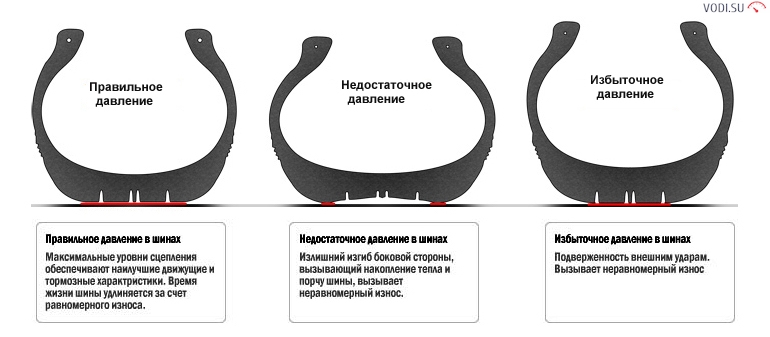
What should be the pressure in the tires of the car? Winter and summer
When choosing tires, you need to pay attention to a number of parameters:
- tire size;
- seasonality - summer, winter, all season;
- tread type - track, off-road;
- manufacturer - Nokian, Bridgestone or Kumho rubber is superior in its characteristics to products from other companies.
We already wrote on Vodi.su about how to decipher the information on the tire court. Among other things, here you can find such an indicator as Max Pressure or Maximum Allowable Pressure. If you open the tank hatch, you will find a sticker on the back of it, which indicates the pressure recommended by the vehicle manufacturer for tires of one or another size. This sticker can also be on the B-pillar on the driver's side, on the glove box lid. There are instructions in the instructions.

Optimum pressure value
It is usually measured in atmospheres or kilopascals.
Accordingly, information can be presented as follows:
- size - 215/50 R 17;
- pressure for the front and rear axles - 220 and 220 kPa;
- pressure at high load - 230 and 270 kPa;
- spare wheel, dokatka — 270 kPa.
You can also see the inscription "For Cold Tires Only" - only for cold tires. What does all this mean? Let's figure it out in order.
Units
The problem is often aggravated by the fact that the pressure is indicated in different units, and if, for example, the pressure gauge has a scale in BAR, and the manufacturer uses atmospheres or kilopascals, then you have to look for a calculator and a unit converter.
In fact, everything is not as difficult as it seems:
- 1 BAR - 1,02 one technical atmosphere or 100 kilopascals;
- 1 technical atmosphere is 101,3 kilopascals or 0,98 bar.
Having a mobile phone with a calculator at hand, it will be easy to convert one value to another.
On cars and pressure gauges made in England or the USA, a different unit of measure is used - pounds per square inch (psi). 1 psi equals 0,07 technical atmospheres.
Accordingly, from the above example, we see that the optimal pressure for a car is indicated on a special sticker, and in our case it is 220 kPa, 2,2 bar or 2,17 atmospheres. If you load the car to the maximum, then the wheels should be pumped up to the desired value.

It should also be mentioned that these indicators are calculated for optimal driving conditions on quality roads. If you mainly drive on broken roads and off-road, then a decrease in the recommended pressure is allowed:
- in summer by 5-10 percent;
- winter 10-15.
This is done so that the rubber becomes softer, and the shocks are not so hard perceived by the suspension.
Based on the foregoing, you need to follow the manufacturer's recommendations, nevertheless, tires can be lowered, but not more than 15 percent in winter.
Cold and hot tires
Another important point is the correct timing for measuring tire pressure. The thing is that during the friction of rubber on asphalt, it heats up a lot, the same happens with the air inside the chamber. When heated, as is known, all bodies expand, including gases. Accordingly, immediately after stopping the pressure, it is unlikely that it will be possible to measure the pressure correctly, so you either need to wait 2 hours at the gas station, or get your own pressure gauge and take measurements in the morning.
The exact opposite happens in winter - the air cools and the pressure level drops during the night stay. That is, measurements are taken either in a heated garage, where the temperature is above zero, or after a short trip.
It is recommended to measure blood pressure at least once a month in summer and twice a month in winter.

Lowered tires - pros and cons
In winter, many drivers lower their tires, citing the fact that the contact patch with the road and grip increase. On the one hand, everything is correct, but the stick has two ends and you will have to put up with the following consequences:
- controllability worsens;
- when cornering, the car loses stability;
- the braking distance increases.
Add to this the increased oil and fuel consumption, as rolling resistance increases.
Thus, based on the foregoing, we come to the following conclusions:
- the best option is to adhere to the requirements of the machine manufacturer;
- you can lower the wheels, but not more than 15%, while a number of negative consequences appear;
- correct pressure readings can only be obtained on cold rubber.
Loading…